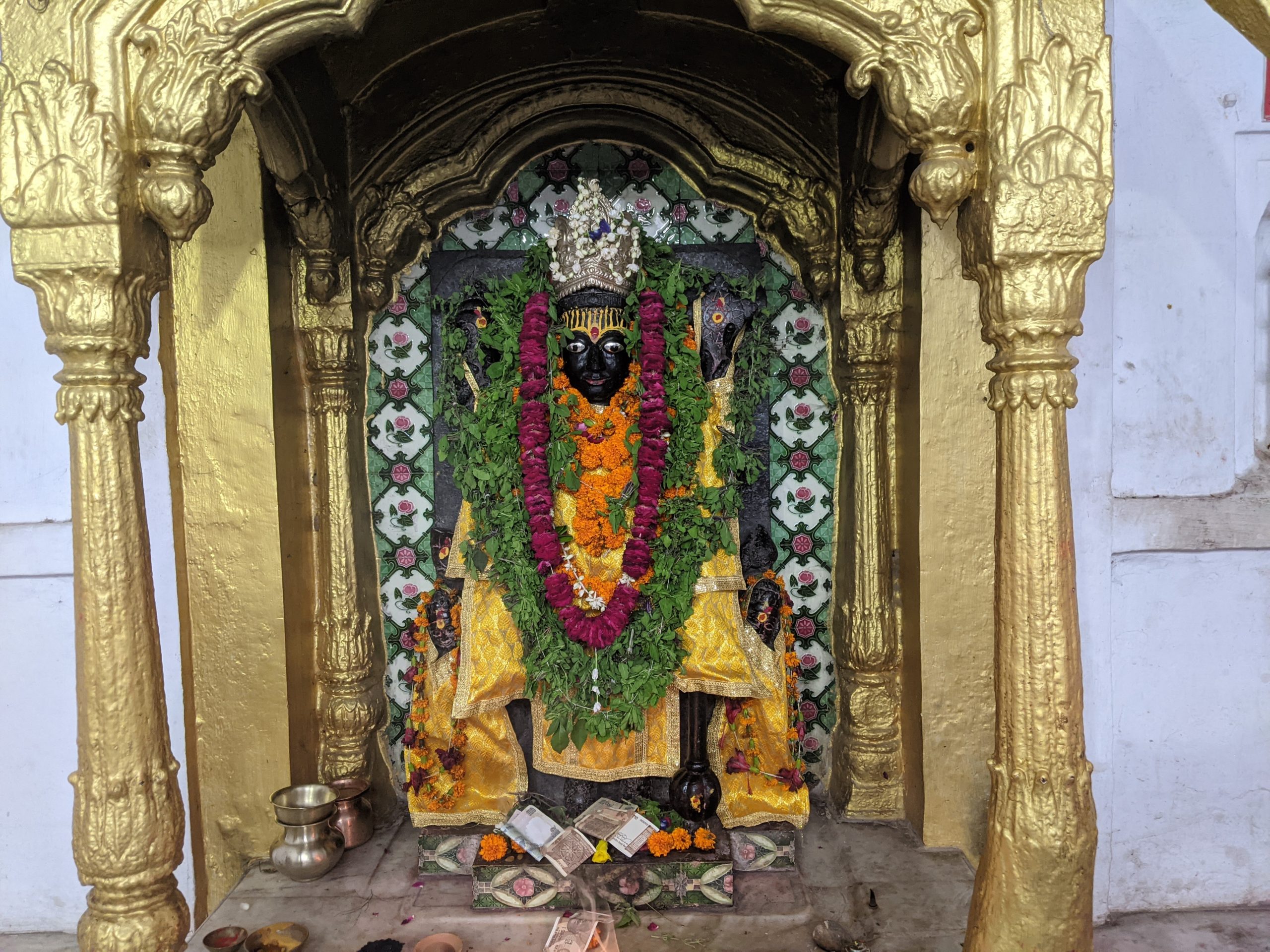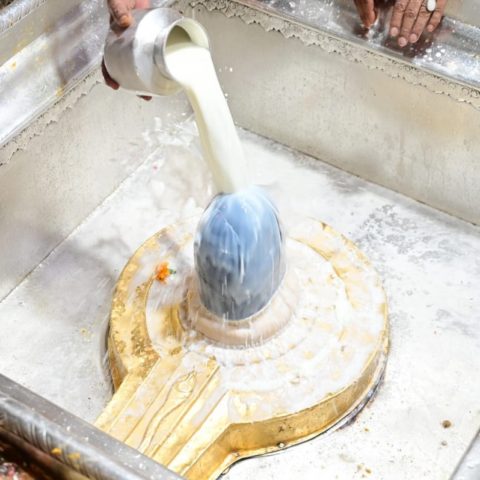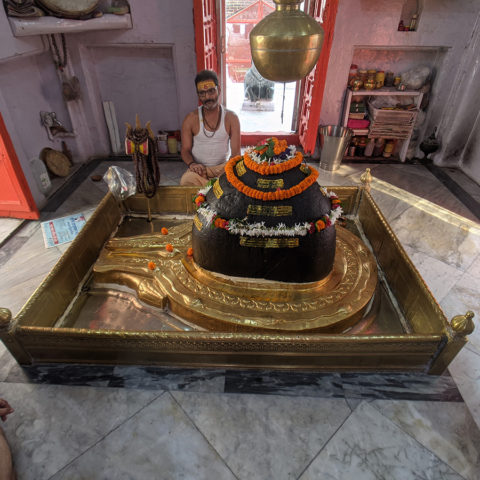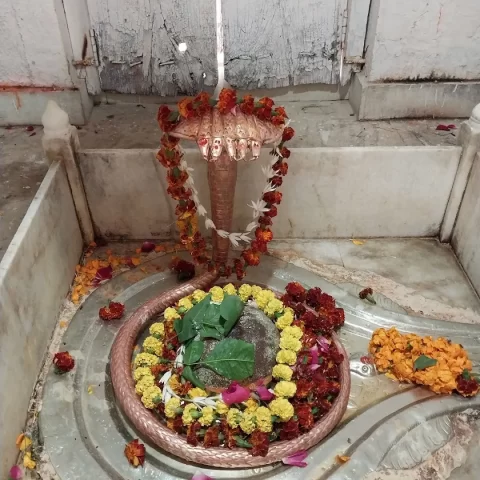
Adi Keshav Temple in Varanasi is the oldest temple in Kashi. The temple is dedicated to Lord Keshava, a form of Lord Vishnu. Kashi has Sixteen Keshava temples out of which Adi Keshav Temple is the most prominent one. In fact the adi pati of Kashi is Lord Keshava. The Deity here was carved by none other than Lord Vishnu Himself as per the Skanda Purana.
The location of Adi Keshav temple is where Lord Vishnu first set foot in Kashi i.e., Adi Keshav Ghat, now called Raj Ghat. The temple has an atmosphere of pristine serenity standing at the confluence of the sacred Ganga and the sacred Varuna rivers. This confluence has been called Padodaka Tirtha after Lord Vishnu bathed in it.
Being the oldest or one among the oldest, Adi Keshav temple has witnessed the many events and happenings in Kashi. Due to years of neglect, the temple is not well-known except amongst the locals. But it’s importance cannot be ignored ever. The temple was used as a military outpost by the British after the mutiny of 1857. Hence, you can see holes with pipes in it on the building walls.
Later, the temple was handed over to the state of Gwalior. Sri Scindia Divan Madho of the Gwalior state restored the Adi Keshav temple after it was destroyed by Qutub-Udin-Aibak in 1194 CE.
How did Lord Adi Keshav come to reside in Kashi?
The establishment of the Adi Keshav Temple in Kashi has been spoken in the Kashi Khanda of the Skanda Purana. Lord Vishnu entered Kashi for the very first time to fulfil the desire of Lord Shiva who wanted to go back to his own city i.e., Kashi.
Lord Shiva had left Kashi once for the beautiful Mandara mountain who had performed penances to please him. He was also requested by Lord Brahma to do so. Along with Lord Shiva, all the Deities of Kashi left for the Mandara mountain. Even the other Deities on earth left their respective abodes and reached the Mandara mountain.
A righteous ruler by the name King Divodasa started ruling the earth from Kashi as per the instructions of Brahma on a condition that his rule should be faultless. King Divodasa was extremely righteous that no one could find any fault in him or his activities. His citizens lived very happily. There were no problems in his kingdom such as thieves, natural disturbances, etc.
He was impartial in his dealings with his citizens. The righteous were honoured while the non-righteous were punished. Hence, the demigods were envious of him. The demigods made many attempts to defame him. They even forced Agnideva to withdraw from Kashi all the three kinds of sacrificial fires as well as the digestive fire in the stomach.
But King Divodasa found an alternative solution and protected his citizens by his strong penances. The King was also known for his respect towards the Brahmanas. He had ruled Kashi for 80,000 years.
Lord Shiva’s suffering in separation of Kashi
Meanwhile, Lord Shiva was burning with separation from Kashi. No coolant could ever cool him down. Even the wind blowing from Kashi was enough to cool him. Sandalwood paste was applied on his body, tender lotus stalks were tied on his body and many other things were done to cool Lord Shiva. But none had any effect.
He mentally bore all the distress due to his separation from Kashi even though he appeared composed on the outside. He was thinking that even the distress created by the separation of Sati Devi was compensated by the arrival of Parvati Devi. But the fire of separation from Kashi was far bigger than that.
Understanding the situation of Lord Shiva, Parvathi Devi described the glories of Kashi and told him that they should leave for Kashi immediately. Hearing this, Lord Shiva became extremely happy and pleased with Parvathi Devi. He assured that he would endeavour to reach Kashi at the earliest. Lord Shiva was thinking of a way to remove King Divodasa from Kashi.
At that time, he saw a group of yoginis. After consulting with Parvathi Devi, he sent the group of 64 yoginis on a mission to Kashi. The 64 yoginis had to create a situation or find a loophole where King Divodasa would get fed up and abandon the throne. The yoginis gladly accepted the order of Lord Shiva and set forth to Kashi.
They entered Kashi in irregular ways and adopted various looks and activities using their mystic powers. One yogini became a dancer while another became an expert in palmistry. In this way, all the yoginis took up different activities or professions in order to fulfil the mission of Lord Shiva. But none of them could find a fault in King Divodasa.
They finally gave up and decided to live in Kashi enchanted by the city. They were also afraid of going back and telling their master that they could not accomplish his mission.
Lord Shiva sent his attendants, the Ganas, to Kashi as the yoginis hadn’t returned. But they too didn’t report back to Lord Shiva. The Ganas weren’t able to influence the residents of Kashi. Thus, lamenting about their failure, they decided to stay back in Kashi establishing Shivalingas and worshiping them.
In this way, Lord Shiva sent Surya-deva and Lord Brahma. Surya-deva and Lord Brahma too couldn’t find any fault in King Divodasa and hence, decided to stay in Kashi. In fact, Lord Brahma wanted to perform an Ashwamedha yagna on the banks of the sacred Ganga. But King Divodasa arranged for a Dashashwamedha yagna. Thus, the site of the Dashashwamedha yagna came to be known as the Dashashwamedha ghat.
Being worried that the 64 yoginis, the Ganas, Surya-deva and Lord Brahma didn’t return from the mission they were sent for, Lord Shiva called for his son Ganesha. He ordered Ganesha to go to Kashi and find a way to end the rule of King Divodasa. It was Lord Ganesha who turned around things in favour of his father Lord Shiva.
Lord Ganesha charms King Divodasa
Lord Ganesha took the form of a brahmana who dealt in astrology. He visited various houses giving astrological forecasts. He became very popular amongst the queens of the kingdom. They started talking about this old brahmana astrologer to the King indirectly. They glorified his character before the King and also amongst themselves in their private apartments all time.
Once, the chief Queen Lilavathi glorified the brahmana before King Divodasa and told him that he should meet this brahmana. King Divodasa gave permission for the same. Queen Lilavathi sent her clever female companion and called the brahmana to the King’s court.
After a heartful conversation, the brahmana went back and the King was full of praise for him. He extolled the brahmana before Queen Lilavathi and invited the brahmana to his palace the next morning.
King Divodasa asked the old brahmana in private as to what activities were conducive to his welfare. King Divodasa had done many pious activities as a King but his mind was not attracted towards these activities. He wanted to know the highest truth from the brahmana whom he believed to be of high intellect and knowledge.
The old brahmana glorified King Divodasa citing his activities as a true and righteous King. He informed the King that a brahmana from the north would come on the 18th day beginning that day and advise the King. The King was to follow the advice of that brahmana unhesitatingly. Thereafter, Lord Ganesha stayed on in Kashi disguising himself through his powers.
Lord Vishnu arrives in Kashi at Adi Keshav Temple
When Lord Ganesha didn’t return to Mandara mountain, Lord Shiva grew anxious and met Lord Vishnu who offered to help him. Lord Vishnu started for Kashi along with His consort Lakshmi Devi. On reaching Kashi, Lord Vishnu bathed at the confluence of the sacred Ganga and sacred Varuna. From then onwards, this confluence came to be known as Padodaka Tirtha as Lord Vishnu washed His lotus feet here.
Accompanied by Lakshmi Devi and Garuda, Lord Vishnu performed his daily rites here. He carved a Deity of Himself and worshipped it. That region within Kashi where Lord Vishnu bathed and worshiped His own Deity is known as Shwetadvipa.
There are many Tirthas near this region and among them is the Mahalakshmi Tirtha where Lakshmi Devi took her daily bath. Her Deity too has been established there. After entering the very Deity Lord Vishnu carved, He came out of it partially to fulfil Lord Shiva’s mission. Lord Vishnu created an area called Dharmakshetra for His stay to the north of Kashi.
Lord Vishnu assumed the form of a monk named Punyakirti, who was fascinating to the three worlds. Lakshmi Devi became a parivrajika (female mendicant) named Vijnanakaumudi of exquisite beauty. Her appearance made the world motionless. Garuda assumed a unique form and became their disciple with the name Vinayakirti.
The disciple Vinayakirti was very devoted to his master Punyakirti who instructed him about the various tenets of religion including non-violence. The people of Kashi heard about the teachings of Punyakirti from others and went to meet him. Whereas, Vijnanakaumudi asked the residents of Kashi to only believe what they see and seek the happiness of the body. She spoke to the people about the need for material happiness and the various means to achieve it.
She even taught black arts to some. In this way, Punyakirti and Vijnanakaumudi were able to delude the citizens into seeking more material happiness. This led the citizens to commit sinful activities. Thus, the power of King Divodasa who didn’t wish to administer his kingdom anymore reduced.
He was counting the days as predicted by the old brahmana. On the 18th day, Lord Vishnu appeared at the gate of King Divodasa in the form of Punyakirti, a brahmana. The King received Punyakirti with great respect and worshiped him.
The King enquired from Punyakirti about the means to attain happiness. He cited his own achievements as a King. Punyakirti glorified the King and said that there was only one sin that the King had committed. He had kept Lord Shiva away from Kashi.
Hence, the King had to install a Shivalinga and worship it with utmost devotion. The King was very happy that he offered his respects to Punyakirti many times and agreed to do as advised.
Lord Vishnu went away and was thinking of a place in Kashi to stay permanently. He decided to stay at Panchanada permanently as Sri Adi Keshav.
The Festivals at Adi Keshav Temple
The festivals at Adi-Keshav temple are not advertised much. But the temple celebrates the Antagrahi Mela, Varuni mela, Mahabarni mela and Vamana Dwadashi.
Temple Timings of Adi Keshav Temple
The Adi Keshav temple houses three shrines in the complex apart from Sri Adi Keshav i.e., Gyan Keshav, Sangameshwar and Panchdevta. The Sangameshwar Linga is said to have been consecrated by Lord Adi Keshav Himself. The pillars of the Ranga Mantap have intricated carvings.
You can visit Adi Keshav temple at the following times:
Morning: 06.00 AM to 12.00 PM
Evening: 04:00 PM to 10.00 PM
The route to the Adi Keshav Temple
The Adi Keshav temple is located in the old city of Kashi. It is not even known properly to the residents of Kashi apart from the people who reside in the temple locality. You may find the rickshaw driver confused when you ask him to take you there. You will have to use your phone GPS apart from external help. Mentioning Raj Ghat will make it easier for you.
If you’re travelling on the Kashi Yatra or Ayodhya-Kashi Yatra conducted by Tirtha Yatra, this will not be an issue at all.
Reaching Kashi and getting the divine permissions is important before you are able to reach the temple. Use any of the modes to travel to Kashi:
By Road: Kashi is well connected by road to major cities in India such as New Delhi, Mumbai, Lucknow, etc. You can travel in a private vehicle from other cities or hire a taxi. Luxury buses and normal buses are available from Lucknow frequently.
By Rail: Kashi is very well connected to major cities and towns in India via the five railway stations i.e., Kashi Railway Station, Varanasi Junction (also called Varanasi Cantt), Varanasi City, Banaras Railway Station and Pt. Deen Dayal Upadhyaya Junction. Tickets can be reserved up-to any one of these five stations.
By Air: Kashi is accessible by air through the Lal Bahadur Shastri Airport at Babatpur near Kashi. Domestic and International flights are available from and to the airport. From there, you can take a prepaid taxi to reach the city centre.
1













Comment On Adi Keshav Temple, Kashi
Wow. Great information and description about so revered Vishnu temple in Kashi known as Shiva Nagari.